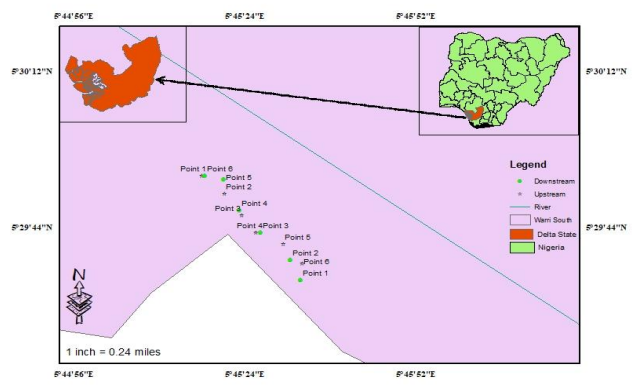The Impact of Sawmill Activities on Surface Water Quality in the Pessu Market Section of the Warri River

Submission to VIJ 2023-10-12
Keywords
- Sawmill Activities, Surface Water, Environmental Impact
Abstract
Solid waste serves as a substantial contributor to environmental contamination by introducing chemical substances into the environment in quantities that exceed acceptable limits. This study aims to ascertain the impact of sawmill activities on the surface water quality in the Pessu market section of the Warri River. Surface water samples were collected from 6 sampling points upstream and 6 sampling points downstream. Sampling and analysis of the surface water was done according to standard methods and procedures. The results of this study showed pH in the ranges of 6.5 – 6.91 and 6.81 – 7.09; turbidity ranged from 44.61- 90.89 NTU and 39.88 – 84.20 NTU; iron varied from 2.70 – 5.62 mg/L and 0.55 – 4.89 mg/L; Cadmium ranged from 0.54 – 0.60 mg/L and 0.55 – 0.74 mg/L for the upstream and downstream respectively. Water quality index result revealed that the water is not suitable for drinking. Turbidity, iron, and cadmium exceeded WHO standard limits for drinking water quality. The exceedances observed in this study are an indication that the sawmill activities may have a negative impact on the surface water quality in the study area. It is therefore recommended to carry out measures to mitigate these exceedances observed.
References
- Fagbenro, O. K; & Abdulfatai, K. (2018). A Review on the Environmental Impact of Sawmill Waste Discharges in Nigeria. Journal of Civil and Environmental Studies 1(1): 1 -10. https:// doi.org/10.36108/laujoces/8102/10(0111).
- Jones, A.; Seville, D.; Meadows, D., (2002). Resource sustainability in commodity systems: the sawmill industry in the Northern Forest. The Journal of the System Dynamics Society 18(2): 171- 204.
- Obasi, H.C; Mark, U.C; Madufor, I. C; Mark, U. (2021). Biochar Filled Polypropylene Composites with Excellent Properties: Towards Maximizing the Utilization of Agricultural Wastes. Journal of Material and Environmental Science 12(8): 1082 – 1097.
- FAO. African fisheries and the Environment FAO Regional Office, Accra, RAFR/91/02, Accra, Ghana. 1991; 26.
- Chinyere, G.C; Obisike, E.S; Ugbogu, A.E; Osuocha, K.U. (2013). Studies on municipal solid wastes dumping on soil anions, cations, and selected enzymes activities at Njoku sawmill waste dumpsite, Owerri Municipal, Imo State, Nigeria. Ethiopian Journal of Environmental Studies & Management 6, 1 -9.
- Akankali, J., Davies, I.C; Blessing, D. (2022). Assessment of Sawmill and other Associated Wastes on the Water Quality of Ilo-abuchi Creek, Rivers State, Niger Delta. Asian Journal of Fisheries and Aquatic Research pp 25.
- Davies, I.C; Efekemo, O. (2022). Physico-chemical Parameters and Heavy Metals Distribution in Selected Shell Fishes along the OpuroAma Creek in Rivers State of Nigeria. Asian Journal of Fisheries and Aquatic Research 17(1):15-26
- Arimoro, F.O; Ikomi, R, B; Osalor, E.C. (2007). The Impact of Sawmill Wood Wastes on the Water Quality and Fish Communities of Benin River, Niger Delta Area, Nigeria. International Journal of Science & Technology 2(1): 1-12.
- Elemile, O.O; Raphae, O.R; Omole, D.O; Oloruntoba, E.O; Ohwavboru, N. A. (2019). Assessment of the impact of abattoir effluent on the quality of groundwater in a residential area of Omu-Aran, Nigeria. Environmental Science of European Journal 31(16): 1 – 6
- Spellman, F.R. (2017). The Science of Environmental Pollution. CRC Press.
- Bhat, N.B., Parveen, S. and Hassan, T. 2018. Seasonal Assessment of Physicochemical Parameters and Evaluation of Water Quality of River Yamuna, India. Advances in Environmental Technology1: 41–49.
- Krishn, K. S., Hari, B. S., Eswar, P.R., Selvakumar, S., Thivya, C., Muralidharan, S., Jeyabal,. G.(2017). Evaluation of Water Quality and Hydrogeochemistry of Surface and Groundwater, Tiruvallur District, Tamil Nadu, India. Applied Water Science 7 (5): 2533-2544.
- APHA (2012). American Public Health Association/American Water Works Association/Water Environment Federation. (2012). Standard Methods for the Examination of Water and Wastewater.22nd Edition, Washington DC, USA. Arafat R, Ishrat J, Yeasmi
- World Health Organization (2011). Guidelines for drinking - water quality. 4th Editon. Geneva.
- Chandra, S.D; Estimation of Water Quality Index by Weighted Arithmetic Water Quality Index Method: A Model Study. International Journal of Civil Engineering and Technology, 8, (4), 1215–1222.
- Nong, X.Z., Shao, D.G., Zhong, H. and Liang, J.K. (2020). Evaluation of Water Quality in the South-to-North Water Diversion Project of China Using the Water Quality Index (WQI) Method. Water Research, 178, 115781.
- Wen, T., Wang, G. and Li, Q. 2007. Effect of Water Turbidity on the Photosynthesis Characteristics of Myriophyllum Spicatum L. Asian Journal of Plant Science 6(5): 773 -780.
- Usman, L.U., Nnamdi, S. and Nafiu, S.A. (2017). Effects of Physico-chemical Parameters on the Composition and Abundance of Phytoplankton in Ajiwa Reservoir Katsina State,Northwestern Nigeria. Bayero Journal of Pure and Applied Science 10(2):16-24.
- Jain, S. K; & Singh, V. P. (2003). Developments in Water Science. Elsevier. https://doi.org/10.1016/S0167-5648(03)80067-9.
- Oribhabor, B. J; & Ogbeibu, A. E.(2009). Concentration of Heavy Metals in a Niger Delta Mangrove Creek, Nigeria. Global Journal of Environmental Sciences 8(2): 1 – 10.